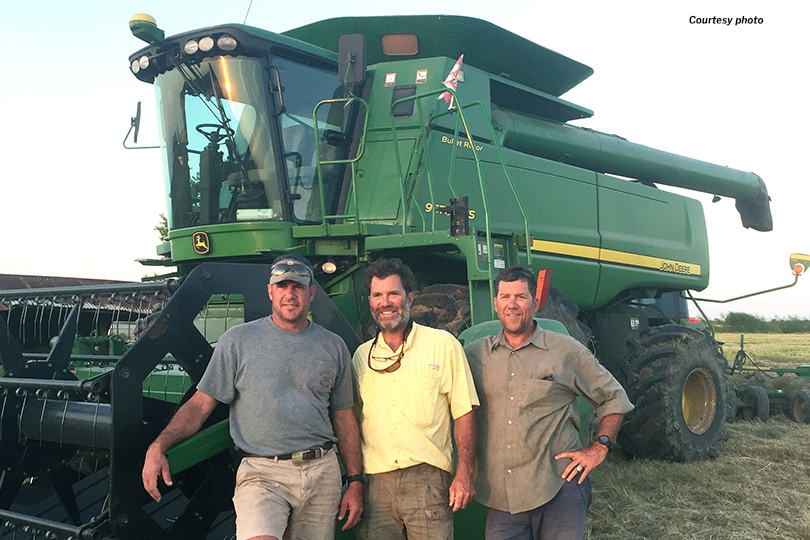By Jennifer Dorsett
Field Editor
More than half of the world’s population gets most of its nutrition from one tiny, but mighty, grain—rice.
And some of that rice is grown in the Lone Star State by families like the Kellys.
Colorado County Farm Bureau member Tom Kelly has been growing the crop for 18 years.
“I’m a fifth-generation rice farmer. My great-great-grandfather moved here in 1897 from Iowa, where he was most likely farming corn,” Kelly said. “He started off in Texas as a well-digger, and when rice entered our area in about 1903, he started farming rice soon thereafter. My brothers and I farm some of the same land he farmed, so that’s pretty special.”
It’s a family legacy he is proud to continue, despite some challenges.
“Rice farming has become far more expensive over the past couple of decades,” Kelly said. “The equipment costs more, and water costs much more now. All the inputs have gone up, so there’s certainly fewer acres being farmed now than when I first started.”
The Colorado River, namesake of the county in which Kelly’s family and his brothers, Tim and Trent, grow rice and raise cattle, flows throughout the countryside, providing irrigation to nourish the water-intensive crop.
Most of the time, anyway.
“We get our water from water wells and the Lower Colorado River Authority,” Kelly said. “In 2012 to 2015, we had zero water allocation to ‘interruptible water customers,’ which is agricultural irrigation customers like myself. Crop insurance came in and saved us during that drought, but I honestly think the communities suffered more—parts stores, diesel suppliers, dealerships, tire shops. Everyone was really hurt by those actions, and it put a lot of people out of business.”
A lack of water, increased input costs and urban encroachment have all taken their toll. Kelly said Texas farmers used to farm more than 600,000 acres of rice, but he estimates there are now less than 200,000 acres of rice grown annually in the state.
But he and his family have persevered, adapting as necessary to keep the family legacy alive.
Common varieties have changed, and yields have increased as a result, Kelly noted.
“We harvest by barrels and sell by the hundredweight. A barrel, a colloquialism we use, is 162 pounds,” he said. “So, 50-barrel yields used to be great, but now 60 barrels is probably the new threshold for a good yield.”
Harvested rice is cut, dried and stored in local elevators usually owned by one of the four main buyers in Texas, who then clean and polish the rice before selling to grocery store chains, including H-E-B and Kroger.
Most Texas-grown rice that’s exported goes to Saudi Arabia and Mexico.
And rice prices are better than they have been in a while.
“July futures reached $22 per hundredweight, but that was for 2019 crops in storage, and no one that I know of had any rice leftover that was unsold at that time,” Kelly said. “It sounds really good, but it’s a simple case of supply and demand. The reason we hit that number is there was no rice available that had not been sold.”
Kelly sold some rice last year for $13.50/hundredweight, but most of his crop sold at $12.50-$13/hundredweight.
“And two years ago, I sold most of my rice for $10-11 a hundredweight, so the prices we have right now are far better than what they had been,” he said.
Like any farmer, Kelly has his concerns and his share of not-so-great days. But all things considered, there’s nowhere else he’d rather be.
“I’m proud to say that I’m a fifth-generation farmer farming the same land my great-great-grandfather farmed at the first part of the last century,” he said.


Proud of you—feels like family!
This is so awesome!! So proud of you!! You hunted frogs in my neighborhood when you were little!!!
Thank you for keeping pride in farming!!! Texas farmers are making a difference across the nation.
Proud to have known the Thomas family for four generations!
What a great family heritage and tradition Tom! Glad to say I know you and went to Conroe High School and TAMU with you. Whoop!
Great article on the Kelley family.
True perseverance from Tom and his brothers to keep a family tradition going strong.
So great- I love family Legacies! This is one wonderful family!
Not only great farmers but great men! Glad to be able to call them friends but cousins!
Keep up the tradition. Been a pleasure to work w u n your family